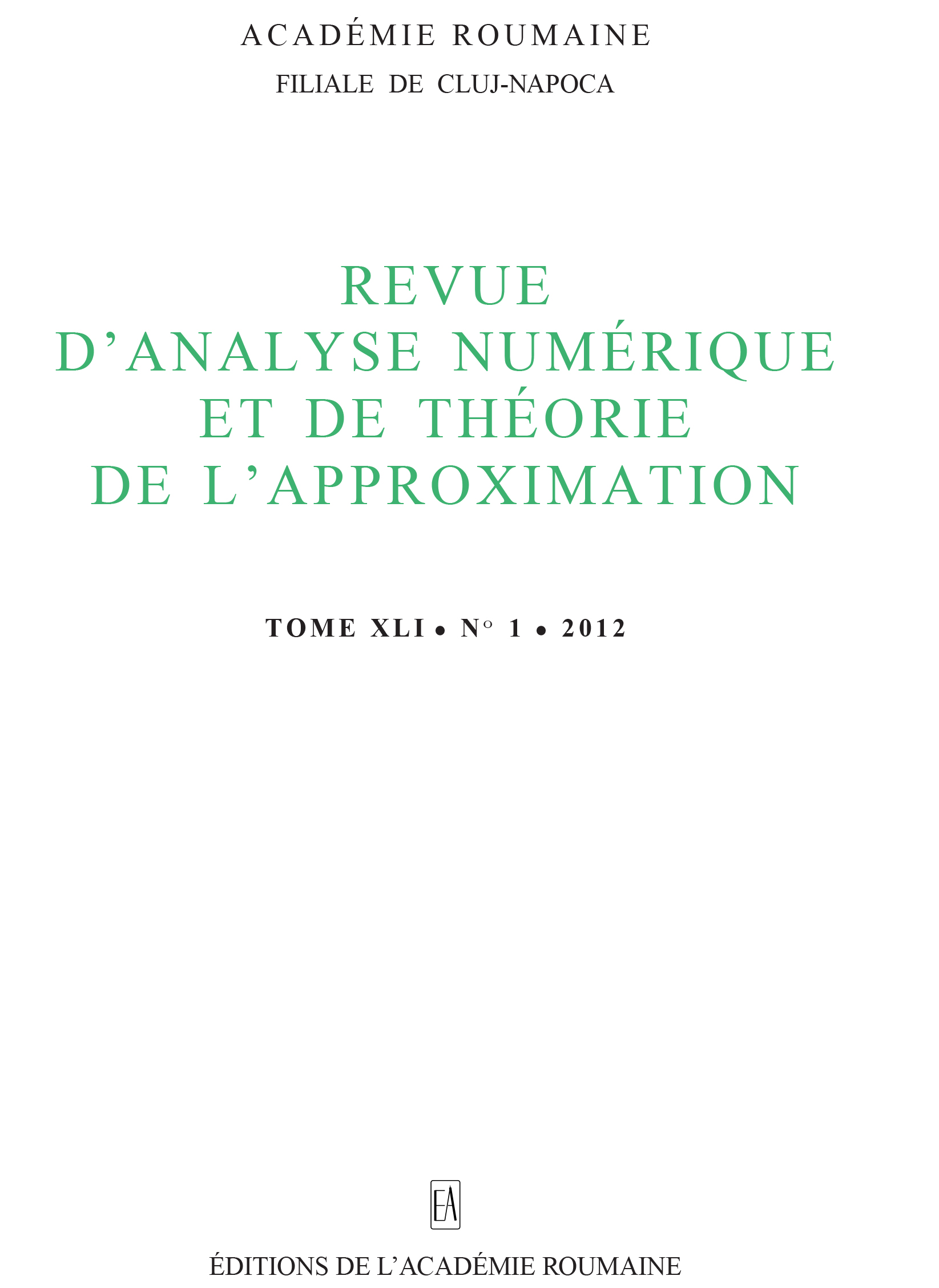On the semilocal convergence of derivative free methods for solving nonlinear equations
DOI:
https://doi.org/10.33993/jnaat411-964Keywords:
Banach space, derivative free method, Newton's method, divided difference, recurrence relationsAbstract
We introduce a Derivative Free Method (DFM) for solving nonlinear equations in a Banach space setting. We provide a semilocal convergence analysis for DFM using recurrence relations. Numerical examples validating our theoretical results are also provided in this study to show that DFM is faster than other derivative free methods [9] using similar information.Downloads
References
I.K. Argyros, Polynomial operator equations in abstract spaces and applications, St. Lucie/CRC/Lewis Publ. Mathematics series, 1998, Boca Raton, Florida, U.S.A.
I.K. Argyros, On the Newton-Kantorovich hypothesis for solving equations, J. Comput. Appl. Math., 169, pp. 315-332, 2004. https://doi.org/10.1016/j.cam.2004.01.029 DOI: https://doi.org/10.1016/j.cam.2004.01.029
I.K. Argyros, A unifying local-semilocal convergence analysis and applications for two-point Newton--like methods in Banach space, J. Math. Anal. Appl., 298, pp. 374-397, 2004. https://doi.org/10.1016/j.jmaa.2004.04.008 DOI: https://doi.org/10.1016/j.jmaa.2004.04.008
I.K. Argyros, New sufficient convergence conditions for the Secant method, Chechoslovak Math. J., 55, pp. 175-187, 2005 https://doi.org/10.1007/s10587-005-0013-1. DOI: https://doi.org/10.1007/s10587-005-0013-1
I.K. Argyros, Convergence and applications of Newton-type iterations, Springer-Verlag Publ., New-York, 2008.
I.K. Argyros, On a two-point Newton-like method of convergent order two, Int. J. Comput. Math., 88, 2, pp. 219-234, 2005. https://doi.org/10.1080/00207160412331296661 DOI: https://doi.org/10.1080/00207160412331296661
I.K. Argyros, A Kantorovich-type analysis for a fast method for solving nonlinear equations, J. Math. Anal. Appl. 332, pp. 97-108, 2007. https://doi.org/10.1016/j.jmaa.2006.09.075 DOI: https://doi.org/10.1016/j.jmaa.2006.09.075
I.K. Argyros and S. Hilout, On the weakening of the convergence of Newton's method using recurrent functions, J. Complexity, 25, pp. 530-543, 2009. https://doi.org/10.1016/j.jco.2009.06.003 DOI: https://doi.org/10.1016/j.jco.2009.06.003
I.K. Argyros, J. Ezquerro, J.M. Gutiérrez, M. Hernández and S. Hilout, On the semilocal convergence of efficient Chebyshev-Secant-type methods, J. Comput. Appl. Math., 235, pp. 3195-3206, 2011. https://doi.org/10.1016/j.cam.2011.01.005 DOI: https://doi.org/10.1016/j.cam.2011.01.005
W.E. Bosarge and P.L. Falb, A multipoint method of third order, J. Optimiz. Th. Appl., 4, pp. 156-166, 1969. https://doi.org/10.1007/bf00930576 DOI: https://doi.org/10.1007/BF00930576
E. Catinas, On some iterative methods for solving nonlinear equations, Rev. Anal. Numér. Théor. Approx., 23, 1, pp. 47-53, 1994, http://ictp.acad.ro/jnaat/journal/article/view/1994-vol23-no1-art4
S. Chandrasekhar, Radiative transfer, Dover Publ., New-York, 1960.
J.E. Dennis, Toward a unified convergence theory for Newton-like methods, in Nonlinear Functional Analysis and Applications L.B. Rall, Ed., Academic Press, New York, pp. 425-472, 1971. https://doi.org/10.1016/b978-0-12-576350-9.50010-2 DOI: https://doi.org/10.1016/B978-0-12-576350-9.50010-2
J.A. Ezquerro and M.A. Hernández, An optimization of Chebyshev's method, J. Complexity, 25, pp. 343-361, 2009. https://doi.org/10.1016/j.jco.2009.04.001 DOI: https://doi.org/10.1016/j.jco.2009.04.001
M.A., Hernández, M.J. Rubio and J.A., Ezquerro, Solving a special case of conservative problems by Secant--like method, Appl. Math. Cmput., 169, pp. 926-942, 2005. https://doi.org/10.1016/j.amc.2004.09.070 DOI: https://doi.org/10.1016/j.amc.2004.09.070
M.A. Hernández, M.J. Rubio and J.A. Ezquerro, Secant--like methods for solving nonlinear integral equations of the Hammerstein type, J. Comput. Appl. Math., 115, pp. 245-254, 2000. https://doi.org/10.1016/s0377-0427(99)00116-8 DOI: https://doi.org/10.1016/S0377-0427(99)00116-8
M. Grau and M. Noguera, A variant of Cauchy's method with accelerated fifth-order convergence. Appl. Math. Lett., 17, pp. 509-517, 2004. https://doi.org/10.1016/s0893-9659(04)90119-x DOI: https://doi.org/10.1016/S0893-9659(04)90119-X
Z. Huang, A note of Kantorovich theorem for Newton iteration, J. Comput. Appl. Math., 47, pp. 211-217, 1993. https://doi.org/10.1016/0377-0427(93)90004-u DOI: https://doi.org/10.1016/0377-0427(93)90004-U
L.V. Kantorovich and G.P. Akilov, Functional Analysis, Pergamon Press, Oxford, 1982.
V.A. Kurchatov, On a method of linear interpolation for the solution of functional equations, Soviet Math. Dokl., 12, 3, pp. 835-838, 1971.
P. Laasonen, Ein überquadratisch konvergenter iterativer algorithmus, Ann. Acad. Sci. Fenn. Ser I, 450, pp. 1-10, 1969. https://doi.org/10.5186/aasfm.1969.450 DOI: https://doi.org/10.5186/aasfm.1969.450
J.M. Ortega and W.C. Rheinboldt, Iterative Solution of Nonlinear Equations in Several Variables, Academic Press, New York, 1970.
F.A. Potra, Sharp error bounds for a class of Newton-like methods, Libertas Mathematica, 5, pp. 71-84, 1985.
J.W. Schmidt, Untere Fehlerschranken fur Regula--Falsi Verhafren, Period. Hungar., 9, pp. 241-247, 1978. https://doi.org/10.1007/bf02018090 DOI: https://doi.org/10.1007/BF02018090
S.M. Shakhno, About the difference method with quadratic convergence for solving nonlinear operator equations, PAMM, 4, 1, pp. 650-651, 2004 DOI: https://doi.org/10.1002/pamm.200410306
T. Yamamoto, A convergence theorem for Newton-like methods in Banach spaces, Numer. Math., 51, pp. 545-557, 1987. https://doi.org/10.1007/bf01400355 DOI: https://doi.org/10.1007/BF01400355
M.A. Wolfe, Extended iterative methods for the solution of operator equations, Numer. Math., 31, pp. 153-174, 1978. https://doi.org/10.1007/bf01397473 DOI: https://doi.org/10.1007/BF01397473
Published
Issue
Section
License
Copyright (c) 2015 Journal of Numerical Analysis and Approximation Theory

This work is licensed under a Creative Commons Attribution 4.0 International License.
Open Access. This article is distributed under the terms of the Creative Commons Attribution 4.0 International License, which permits unrestricted use, distribution, and reproduction in any medium, provided you give appropriate credit to the original author(s) and the source, provide a link to the Creative Commons license, and indicate if changes were made.










